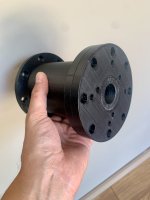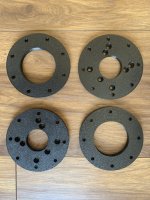Found some screenshots of the Lavoce DF10.171K (but it's not EQed to a flat FR).
Matched adapter:


Extended adapter:


Matched adapter:
Extended adapter:
The effect of filling the long adapter with open-cell foam:

With foam:

Without foam:

Except the overall attenuation, there's almost no difference at high frequencies, which IMHO means that it must all happen inside the driver, even before it enters the throat of the horn. Then it just passes once through the waveguide.
Group delay:

With foam:
Without foam:
Except the overall attenuation, there's almost no difference at high frequencies, which IMHO means that it must all happen inside the driver, even before it enters the throat of the horn. Then it just passes once through the waveguide.
Group delay:
Last edited:
Group delays zoomed (with and without the foam). There's actually something around 17 kHz that the foam seems to improve, but this is so high and basically out of band that this is of little interest.

No foam, excess group delay in ARTA (the black curve), i.e. the difference between the measured one and the one corresponding to the minimum phase calculated from the magnitude frequency response:

Actually, this could be a HOM.
No foam, excess group delay in ARTA (the black curve), i.e. the difference between the measured one and the one corresponding to the minimum phase calculated from the magnitude frequency response:
Actually, this could be a HOM.
Last edited:
Just for info:Found some screenshots of the Lavoce DF10.171K (but it's not EQed to a flat FR).
Matched adapter:
View attachment 1339929 View attachment 1339931
8BQ
Great work Mabat!
Could it be that the foam introduces some acoustic impedance at the very high frequencies that dampens the resonance?
Have you tried to measure the driver on a baffle or in free space to see if the resonance is caused by the horn?
Could it be that the foam introduces some acoustic impedance at the very high frequencies that dampens the resonance?
Have you tried to measure the driver on a baffle or in free space to see if the resonance is caused by the horn?
Kiss that goodbye. Plane Wave Tube, or very low levels. Not so easy on a baffle.Have you tried to measure the driver on a baffle or in free space to see if the resonance is caused by the horn?
My guess up where none of us can hear, is a serious resonance. It's a short enough wavelength that it could be a reflection. Did you stuff the entire throat with the reticulated foam?Group delays zoomed (with and without the foam). There's actually something around 17 kHz that the foam seems to improve, but this is so high and basically out of band that this is of little interest.
View attachment 1339947
No foam, excess group delay in ARTA (the black curve), i.e. the difference between the measured one and the one corresponding to the minimum phase calculated from the magnitude frequency response:
View attachment 1339950
Actually, this could be a HOM.
It is just around these frequencies where the higher order modes of the source start to propagate: https://www.diyaudio.com/community/...-design-the-easy-way-ath4.338806/post-6677700
It could be one of those. Resonances within the fundamental mode apparently don't cause an excess group delay. The value of the delay in this case seems rather high to me, hard to say if it makes sense, I can't imagine the propagation anyway and I can't spend too much time analyzing this at the moment, but would like to get back to this some day, in a more systematic way, including an effect on directivity.
In this particular case (and probably in most cases with a 1" throat), it can be safely ignored, IMO. Put a piece of foam inside the waveguide and forget about it...
It could be one of those. Resonances within the fundamental mode apparently don't cause an excess group delay. The value of the delay in this case seems rather high to me, hard to say if it makes sense, I can't imagine the propagation anyway and I can't spend too much time analyzing this at the moment, but would like to get back to this some day, in a more systematic way, including an effect on directivity.
In this particular case (and probably in most cases with a 1" throat), it can be safely ignored, IMO. Put a piece of foam inside the waveguide and forget about it...
Last edited:
These are the throat impedances for the first axisymmetric HOM of the source:
A520G2/25-EXT-1 (1" long throat)

A520G2/36-STD-1 (1.4" standard throat):

A520G2/DF10.171K matched adapter (~standard 1"):

A520G2/25-EXT-1 (1" long throat)
A520G2/36-STD-1 (1.4" standard throat):
A520G2/DF10.171K matched adapter (~standard 1"):
Last edited:
Printed the missing parts and finished rough sanding the first horn. Here is a dry fit test. The jig is a lifesaver! Thanks Mabat.I'm glad it's clear now. Let us know how it goes. It shouldn't be too hard but it's not always easy either 🙂
Attachments
So if were a HOM, and you measured the on-axis response at different distances from the horn, you should be able to observe the peak "coming and going" ?It is just around these frequencies where the higher order modes of the source start to propagate: https://www.diyaudio.com/community/...-design-the-easy-way-ath4.338806/post-6677700
It could be one of those. Resonances within the fundamental mode apparently don't cause an excess group delay. The value of the delay in this case seems rather high to me, hard to say if it makes sense, I can't imagine the propagation anyway and I can't spend too much time analyzing this at the moment, but would like to get back to this some day, in a more systematic way, including an effect on directivity.
In this particular case (and probably in most cases with a 1" throat), it can be safely ignored, IMO. Put a piece of foam inside the waveguide and forget about it...
....or at least appearing at a distance, while being absent close to the horn...
Excuse my ignorance, I have a question. If one has access to big 3d printers, is it still not recommended to print these horn flares in one piece. Does it not print out properly? If it can be printed properly and the limitation is the print bed size hence the petal approach, would it be possible to get stl files for whole horn flares in cults?
I fail at applying a guiding curve to a R-OSSE waveguide. What parameter am I missing that needs to be included to make it work? I used:
Anything else?
GCurve.Type =
GCurve.SF =
GCurve.Width =
GCurve.Dist =
Anything else?
I'd argue not worth it. All those side flanges that allows gluing together also raise the stiffness and therefore the resonance of the horn. That's worth a lot in terms of how a high frequency horn sounds in the real world.Excuse my ignorance, I have a question. If one has access to big 3d printers, is it still not recommended to print these horn flares in one piece. Does it not print out properly? If it can be printed properly and the limitation is the print bed size hence the petal approach, would it be possible to get stl files for whole horn flares in cults?
I'm doing that currently with some larger horns. I think its a good idea to if you have the means to do it right. Rigidity is the primary concern, so you'll want to modify the meshes to include some degree of ribbing & gussets exterior to the horn walls. There's a lot of literature in the plastic injection molding world on how this is best accomplished. Worth looking at how other OEMs have done it for inspiration i.e. the ME464 below.Excuse my ignorance, I have a question. If one has access to big 3d printers, is it still not recommended to print these horn flares in one piece. Does it not print out properly? If it can be printed properly and the limitation is the print bed size hence the petal approach, would it be possible to get stl files for whole horn flares in cults?
What's the resonance like on larger horns like that one?
Esp with a lower freq, large format driver.
The ribs will help of course.
Guess a further coating or heavy bitumen damping sheet would fix.
Esp with a lower freq, large format driver.
The ribs will help of course.
Guess a further coating or heavy bitumen damping sheet would fix.
This is the ME464 with a DCX464 CD on it.What's the resonance like on larger horns like that one?
Esp with a lower freq, large format driver.
Processed with steep hpf @ 300Hz.
- Home
- Loudspeakers
- Multi-Way
- Acoustic Horn Design – The Easy Way (Ath4)


